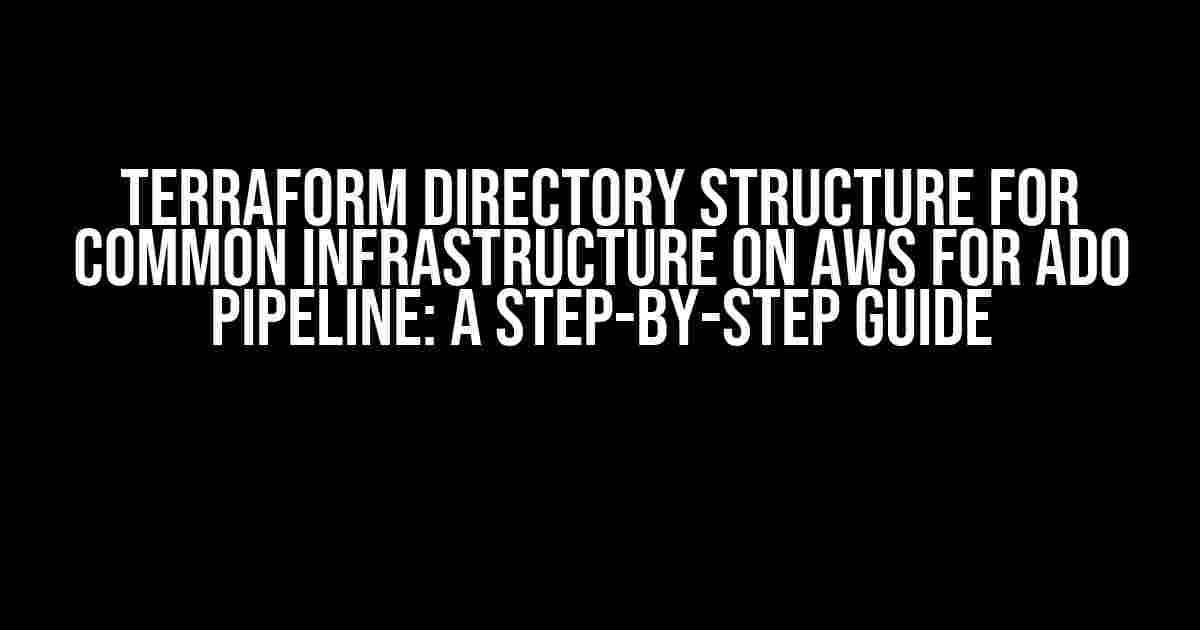As an infrastructure engineer, setting up a robust and scalable infrastructure on AWS can be a daunting task, especially when it comes to managing directories and files. In this article, we’ll dive into the world of Terraform and explore the best practices for creating a directory structure for common infrastructure on AWS using ADO pipeline.
What is Terraform and Why Do We Need It?
Terraform is an open-source infrastructure as code (IaC) tool developed by HashiCorp. It allows you to define and manage your infrastructure using human-readable configuration files. Terraform is essential for managing infrastructure on AWS because it provides a version-controlled and reproducible way to build, update, and destroy resources.
Benefits of Terraform on AWS
- Version Control**: Terraform allows you to manage your infrastructure configuration files alongside your application code in a version control system.
- Reusability**: With Terraform, you can reuse your infrastructure configuration files across multiple environments and projects.
- Infrastructure as Code**: Terraform enables you to treat your infrastructure as code, making it easier to manage and maintain.
Setting Up Terraform Directory Structure for AWS
To create a robust and scalable infrastructure on AWS using Terraform, we need to set up a proper directory structure. Here’s a recommended directory structure for common infrastructure on AWS:
.
terraform/
main.tf
variables.tf
outputs.tf
modules/
networking/
main.tf
variables.tf
outputs.tf
compute/
main.tf
variables.tf
outputs.tf
storage/
main.tf
variables.tf
outputs.tf
...
ado-pipeline/
azure-pipelines.yml
Let’s break down each directory and file:
- terraform/: This is the root directory for your Terraform configuration files.
- main.tf: This file contains the main Terraform configuration for your infrastructure.
- variables.tf: This file defines input variables for your Terraform configuration.
- outputs.tf: This file defines output values for your Terraform configuration.
- modules/: This directory contains reusable Terraform modules for your infrastructure.
- networking/, compute/, storage/: These directories contain Terraform modules for specific infrastructure components.
- ado-pipeline/: This directory contains the Azure DevOps (ADO) pipeline configuration file.
- azure-pipelines.yml: This file defines the ADO pipeline configuration.
Configuring Terraform Modules
Terraform modules are reusable components that contain Terraform configurations for specific infrastructure components. Let’s create a Terraform module for networking:
# modules/networking/main.tf
resource "aws_vpc" "main" {
cidr_block = "10.0.0.0/16"
}
resource "aws_subnet" "public" {
cidr_block = "10.0.1.0/24"
vpc_id = aws_vpc.main.id
availability_zone = "us-west-2a"
}
This module creates a VPC and a public subnet in the us-west-2a availability zone.
Configuring ADO Pipeline
To automate the deployment of your Terraform infrastructure using ADO pipeline, we need to create an azure-pipelines.yml file:
# ado-pipeline/azure-pipelines.yml
trigger:
- main
pool:
vmImage: 'ubuntu-latest'
variables:
terraformVersion: '1.0.0'
stages:
- build
- deploy
build:
stage: build
displayName: 'Build'
steps:
- task: TerraformInstaller@0
displayName: 'Install Terraform'
inputs:
terraformVersion: $(terraformVersion)
- task: TerraformTaskV1@0
displayName: 'Terraform Init'
inputs:
provider: 'aws'
command: 'init'
workingDirectory: '$(System.DefaultWorkingDirectory)/terraform'
deploy:
stage: deploy
displayName: 'Deploy'
steps:
- task: TerraformTaskV1@0
displayName: 'Terraform Apply'
inputs:
provider: 'aws'
command: 'apply'
workingDirectory: '$(System.DefaultWorkingDirectory)/terraform'
This pipeline has two stages: build and deploy. The build stage installs Terraform and initializes the working directory. The deploy stage applies the Terraform configuration to create the infrastructure.
Best Practices for Terraform Directory Structure
Here are some best practices for creating a robust and scalable Terraform directory structure:
- Keep it Simple**: Avoid complex directory structures and naming conventions.
- Use Consistent Naming**: Use consistent naming conventions for your files and directories.
- Separate Concerns**: Separate your Terraform configuration into logical modules and files.
- Use Outputs**: Use output values to share information between Terraform modules and files.
- Version Control**: Use version control systems to manage your Terraform configuration files.
Conclusion
In this article, we explored the best practices for creating a Terraform directory structure for common infrastructure on AWS using ADO pipeline. By following these guidelines, you can create a robust and scalable infrastructure on AWS using Terraform and automate its deployment using ADO pipeline.
| Terraform Directory Structure | ADO Pipeline Configuration |
|---|---|
|
|
By following this guide, you’ll be able to create a robust and scalable infrastructure on AWS using Terraform and automate its deployment using ADO pipeline. Remember to keep your directory structure simple, consistent, and modular, and to use version control systems to manage your Terraform configuration files.
Happy coding!
Frequently Asked Questions
Get ready to terraform your way to a streamlined AWS infrastructure on Azure DevOps (ADO) pipelines! Here are the top questions and answers on the ideal directory structure for common infrastructure on AWS.
What is the recommended top-level directory structure for Terraform on AWS?
The recommended top-level directory structure for Terraform on AWS includes the following folders: `modules`, `environments`, `terraform.tfstate.d`, and `README.md`. The `modules` folder contains reusable Terraform modules, `environments` holds environment-specific configurations, `terraform.tfstate.d` stores Terraform state files, and `README.md` provides an overview of the project.
How do I organize my Terraform modules for a scalable AWS infrastructure?
Organize your Terraform modules into subfolders under the `modules` directory, each representing a specific AWS service or resource type (e.g., `ec2`, `s3`, `vpc`, etc.). This allows for easy discovery and reuse of modules across different environments and projects.
What is the purpose of the `environments` folder in a Terraform directory structure?
The `environments` folder contains environment-specific configurations, such as `dev`, `stg`, and `prod`, each with its own `main.tf` file. This allows you to manage and apply separate Terraform configurations for different environments, ensuring consistency and reuse of infrastructure code.
How do I integrate my Terraform directory structure with an ADO pipeline?
In your ADO pipeline, use the `terraform init`, `terraform validate`, and `terraform apply` tasks to automate the Terraform deployment process. Configure the pipeline to reference the correct environment configuration from the `environments` folder and apply the Terraform code to the targeted AWS infrastructure.
What are some best practices for maintaining and updating my Terraform directory structure?
Regularly review and refactor your Terraform code to ensure consistency and quality. Use version control systems like Git to track changes and collaborate with team members. Test and validate your Terraform configurations thoroughly before applying changes to production environments.


